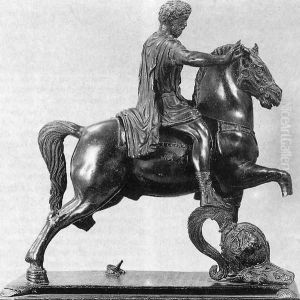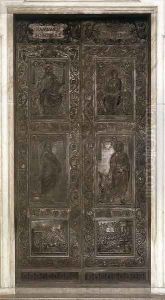Filarete Paintings
Filarete, born Antonio di Pietro Averlino around 1400 in Florence, Italy, was a significant figure in the early Renaissance era, primarily known for his work as an architect, sculptor, and theorist. While the precise details of his early life and training are somewhat obscure, it is believed that he commenced his career in Rome, where he absorbed the classical Roman architectural and artistic traditions that profoundly influenced his later work. By the mid-15th century, Filarete had established himself as a prominent artist, although his exact contributions to architecture and sculpture during this period are not thoroughly documented.
One of Filarete's most notable achievements was the design of the bronze central doors for St. Peter's Basilica in Rome, commissioned in the 1430s. This work, completed in 1445, showcases his mastery of relief sculpture and his ability to integrate Renaissance humanism with Christian themes. Beyond his sculptural endeavors, Filarete made significant contributions to urban planning and architectural theory. His treatise, 'Trattato di Architettura,' completed around 1464, is among the first Renaissance works to systematically discuss architecture. In this treatise, Filarete envisioned the ideal city, Sforzinda, which reflected Renaissance ideals of symmetry, order, and proportion, though it was never built.
Filarete's architectural legacy includes the Ospedale Maggiore in Milan, commissioned by the Duke of Milan, Francesco Sforza, in the 1450s. This project exemplifies his architectural principles, emphasizing practicality, beauty, and the use of innovative building techniques. Despite his significant contributions, Filarete's work was sometimes criticized by contemporaries and later architects for certain perceived eccentricities and impracticalities.
Filarete died in Rome in 1469, leaving behind a legacy that would influence the development of Renaissance architecture and urban planning. His writings, especially the 'Trattato di Architettura,' remained influential long after his death, impacting future generations of architects and theorists. Through his blend of theoretical work and practical application, Filarete stands as a testament to the intellectual and artistic ferment of the Renaissance, bridging the gap between the medieval and modern worlds.

